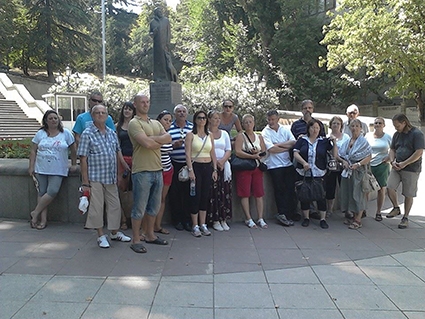Hungarian Delegation Visits Georgia on Hunt for German POW Cemeteries
TBILISI - On August 22-23, the Hungarian Embassy in Tbilisi, Georgia, and the German Circle of Baranya County in Hungary brought a group of ethnic Germans from Hungary to Tbilisi to seek out old cemeteries where German prisoners (POWs) had been buried during and after World War II.
The group of 25, made up of ethnic Hungarians as well as ethnic Germans who have lived in Hungary for the past 200 years, visited Chechnya, Azerbaijan and Georgia within the framework of 2015-2017 memorial years of post-war captives declared by the Hungarian government.
According to the German Association, Tbilisi, around 2000 ethnic Germans live in Georgia today, though the exact number is unknown due to constant migration.
During their time here, the group visited the Saburtalo POW cemetery, as well as that near the Maglivi (High) University block of the Tbilisi State University. They then went to Rustavi, Gardabani, the Hofnungstal-traubental cemetery, Ferdinand Otten’s pharmacy, the 1918 German Embassy, the former Kirche / house of Pastor Meier (Marjanishvili), former Wetzel hotel (Marjanishvili), and former German School (David Aghmashenebeli St.). GEORGIA TODAY met with them during a break.
“This is my first time in Georgia. I’ve heard quite a lot about the country and I’ve always wanted to come here,” said Dr. Peter Szilagyi, Deputy State Secretary, representing Hungary. “The Caucasus has always been a bit of a mystery to me, but at the same time my impressions have always been positive. This is a pilgrimage based on a civil initiative. Hungary is recognizing Memorial Years of German prisoners taken to labor against their will during the times of the Soviet Union, in which both the State and civil organizations are involved. The German circle of Baranya County has organized two tours already,” he told us.
The group comprised a number of Hungarian historians, one of whom was Yuri Dubko: “There have always been economic and cultural ties between the Hungarian and Georgian tribes, as proven by historical sources. The first step in our relations occurred 1,600 years ago with trade and some Georgians are known to have volunteered to fight in the Hungarian armies.”
Dubko was eager to see the country where his ancestors had been kept in camps. “We knew from the surviving PoWs that Georgians had treated them very well and not at all like enemies,” he said. “Sometimes, Georgians took a risk by giving the prisoners bread or sending letters to Hungary on their behalf to tell their families they were alive.”
There were 26 camps in Georgia in which Hungarians, Germans, Romanians and other ethnicities worked. 800,000 Hungarian PoWs were divided between different countries, out of which 300,000 died. There were around 20,000 Hungarian captives just in Tbilisi, 30 per cent of whom were ethnic Germans. Those who died, usually as a result of hunger or lack of medicine, were buried in Tbilisi, Kutaisi, Ochamchire, and other places.
GEORGIA TODAY also spoke with Josef Kompfl, a famous Hungarian architect, an ethnic German, about his personal war story: “In 1945, when I was three, my father was arrested and forced to work in Georgia. He spent one month getting there and I remember him telling me when he got back three years later that around 200 people were taken together with him, also ethnic Germans.”
Among the delegates were representatives of different spheres: Judit Muller, Director of the Janus Pannonius Museum, Hungary, and Josef Chegir, a Hungarian pensioner and former guitar teacher among them. Josef first visited Georgia 40 years ago: “The city has modernized well and you get the sense that people are living better, if I am not misled by these nice views. Tbilisi has increased a lot in size and I see a lot of young children- which tells me that it’s not like Hungary, where the mortality rate surpasses the birth rate. Tourism is looking better than ever, too!” he told GEORGIA TODAY.
Maka Lomadze












